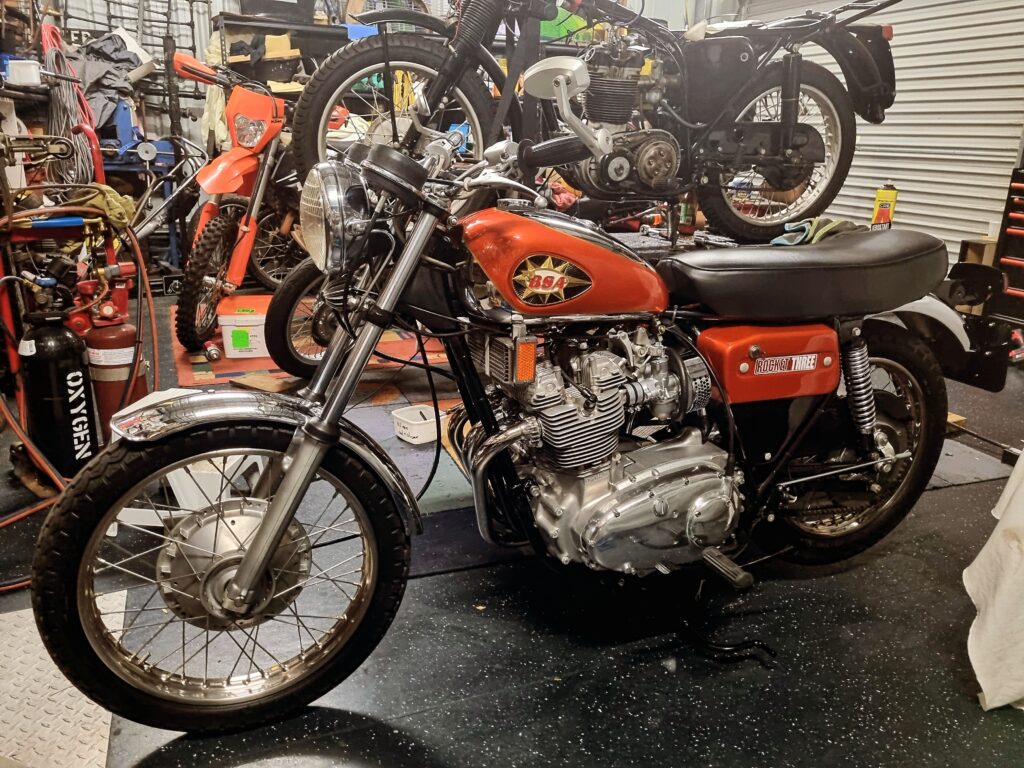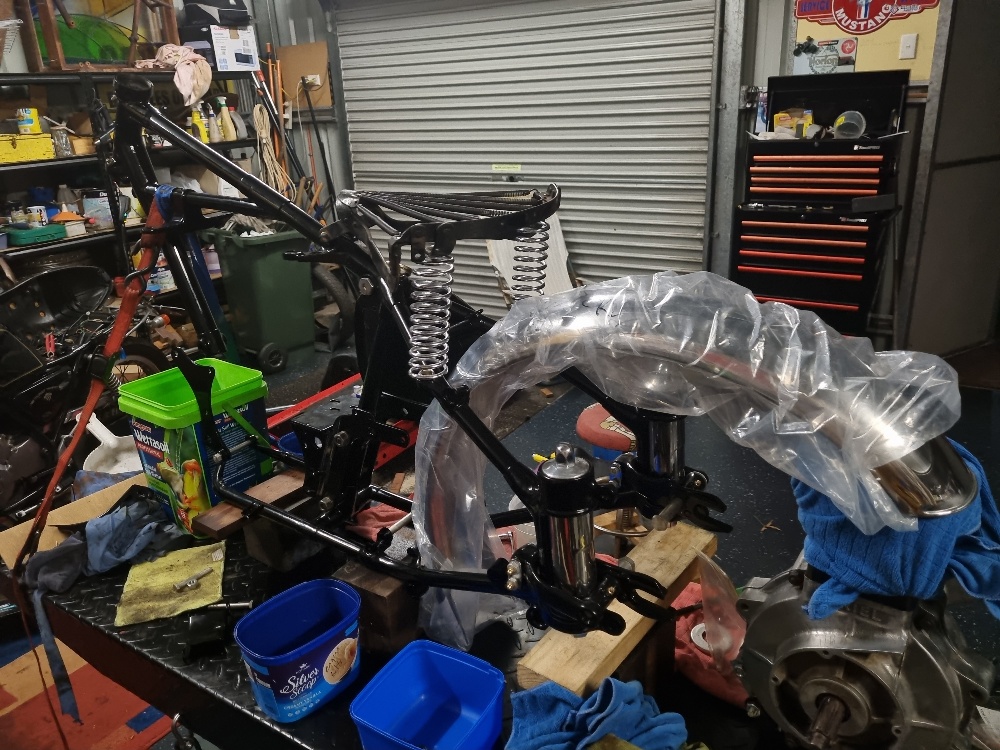Rocket 3 Rebuild, Part IV. She’s done!
By Dan Talbot
The legacy of the BSA Rocket 3 lives on among motorcycle enthusiasts, as it was one of the early examples of a high-performance British motorcycle with a distinctive design and powerful engine configuration. Today, vintage BSA Rocket 3 motorcycles are prized among motorcycle enthusiasts and collectors.
Cast your mind back to 1971. I was in primary school, hooked on dirt bikes and pouring over Dad’s Cycle World magazines (except when I found his stash of Playboy mags). I recall peeling through the pages mainly for dirt bike stories but, if I remember correctly, road machines figured most prominently in Cycle World and the British verse Japanese debate was raging. The Honda 750 and Kawasaki 900 were emerging as unbreakable spaceships compared to the aging British machines, such as Triumphs, Nortons and BSA.
I had leaning towards BSA because at that time my most prized possession was a BSA .177 calibre air rifle. As attractive as the BSA bike and the fashion models draped across it were, I was a little vexed because I felt the Triumph Bonneville was a superior motorcycle. This assessment was based solely on my unscientific observation that the coolest dudes rode Bonnevilles.
Five decades have passed since those days and I have owned no fewer than ten Triumphs, including two Bonnevilles. Aside from my air rifle, I have owned only one BSA and right now it’s taking pride of place in my shed. Purchased in August 2018, it’s been a very long journey to getting the motorcycle back to better than new condition. I know that sounds like a big call but I will make my case below, but first I must backtrack a little.
the Rocket was introduced to readers of the Motor Shed in 2019, with Part II published in March 2021 and, more recently, Part III hit the site in March 2022.

A basket case in the truest sense. This is what we started with!
The restoration has been a five-year journey of industry and hiatus. The industrial component played out in a nexus of time, money and inclination, hiatus occurred when one or more of these positions was challenged or lost. I don’t think it’s an exaggeration to say this has been an epic job – check out the ‘before’ photograph.
The bike was a basket case in the truest sense of the description. I was, at the time, looking for something a little more substantial but as soon as I saw the BSA, I recognised it as a Rocket 3. Importantly, it was one of the latter, American export versions – there are various names used to describe the Mark 2 Rocket, laziness has me resorting to the ‘export’ designation. To my mind, the exports were the more handsome, if not slightly impractical, version of the Rocket. The tiny petrol tank has limited range, there’s so much chrome bouncing back at you riding on a sun-shiny day can be hazardous and the handlebars may hint at Easyrider but when you’re 6’ 3” tall, they more hinderance than help. I have resorted to UK-style Bonneville bars, the likes of which were on my first ever road-bike – a ’76 Bonny.
At the time of spotting the Rocket, I was in search of a Trident engine. Certainly, there were Tridents in the same shed, some of which were for sale, but my resources would only stretch to one project and I seized upon the Rocket for a very reasonable amount. As it would transpire, seized is a good choice of word. The engine had purportedly been rebuilt in the USA. The certificate of title, issued by the Commonwealth of Massachusetts, recorded the milage in June 1975 at 4161. The speedo that came with my bike had 5274 miles on it so one wonders what caused the need for a rebuild. As it turned out, the ‘rebuild’ was more of a rebore, and the pistons had been parked up in the bore for so long, the rings were rusted to the bore. In other words, the rebuild had set me back because the engine was in need of new liners. That was 2018.
The restoration crept along at glacial pace due to competing projects and financial resources. The frame underwent repairs and paint, the tank was re-chromed and painted, wheels rebuilt etc, but the biggie was the engine. I was hearing all sorts of dross about how difficult BSA/Triumph triples are to rebuild and resolved to err on the side of caution. I already had a good relationship with Ben at British Imports in Malaga so resolved to farm the engine rebuild out to them. It was a good, if not expensive, choice. It also took a while but eventually the engine was built. I made a special trip to Perth to collect a sparkling, better-than-new, 750cc triple engine which, incidentally, weighed a healthy 125 kilograms, or the equivalent of a good-sized poddy calf.

I use the calf analogy because getting a recalcitrant beast into a crush, and a BSA 750 engine into a frame, both require three adults, lots of heaving and shoving and can end up with shit all over the place. But we did it. After an hour of struggle the engine was in the frame and the two blokes helping me are still friends.
Along with a complete rebuild, the engine was treated to a new 5-speed transmission, improved oil transfer with a later model (Triumph T160) oil pickup, Trispark electronic ignition and brand-new Amal Premier carbs. Fuel, spark and compression are the essential elements required in the internal combustion engine, hence, electronic ignition and new carburettors are de rigueur whenever I rebuild a motorcycle. In my experience, they are the best guarantee of easy starting and continued running. Ben also talked me into new camshafts and conrods. One night, with perhaps half a glass of shiraz too many, I clicked on an eBay listing for three new MAP Cycle, forged steel conrods and hit ‘buy it now.’ Instantly, I was $1,000 poorer. Poorer still when Ben said I didn’t want those conrods in my engine so they remain boxed up in my shed (fortunately my wife seldom reads my missives).
With the engine back in the frame I hit the bike with new enthusiasm. By that time, most of the paint and chrome had been done. I lost a good deal of time attempting to relace the wheels before sending them off to a professional, only to learn I had purchased the wrong stainless rims of the UK and they were never going to lace up. It’s probably just as well because I wouldn’t want to ride a motorcycle at 120 mph on wheels laced by Dan Talbot.
The last job was the carbs. When Ben received some new stock in mid-23, I quickly loaded the bike up and returned to Malaga. The deal was already in train as Ben insisted on starting the engine and bedding the rings himself. Apparently, there’s a deft science to it and clumsy, backyard mechanics can glaze the bores if they leave the engine idling in the shed for too long. Added to this, had I not taken the bike back to Ben for a start-up, no warrantee would be offered.
There was a litany of small gaffs and foibles on my behalf but, in my defence, this was my first multi-cylinder restoration. I was at the Albany Hill Climb last November when Ben called to list off all the items requiring attention. The worst was my fancy, three into three exhaust system copied from the Triumph Hurricane (another BSA in Triumph clothing). It was brand-new and had me confounded. Likewise, Ben could not make it fit either. We resolved to cut, weld and re-chrome the offending (middle) pipe, which was luckily only one of the three. The chroming alone cost $450!
Eventually, early this month, I got a call saying the bike was running and ready to go. I dropped everything and headed to Perth. When I arrived, I was given starting instructions and kicked the bike into life on the second swing. She sounds absolutely sublime. Any thoughts of flipping the bike to turn a profit evaporated on the ether of a seductive triple bark exiting the faux Hurricane pipes. For now, this one’s a keeper.






